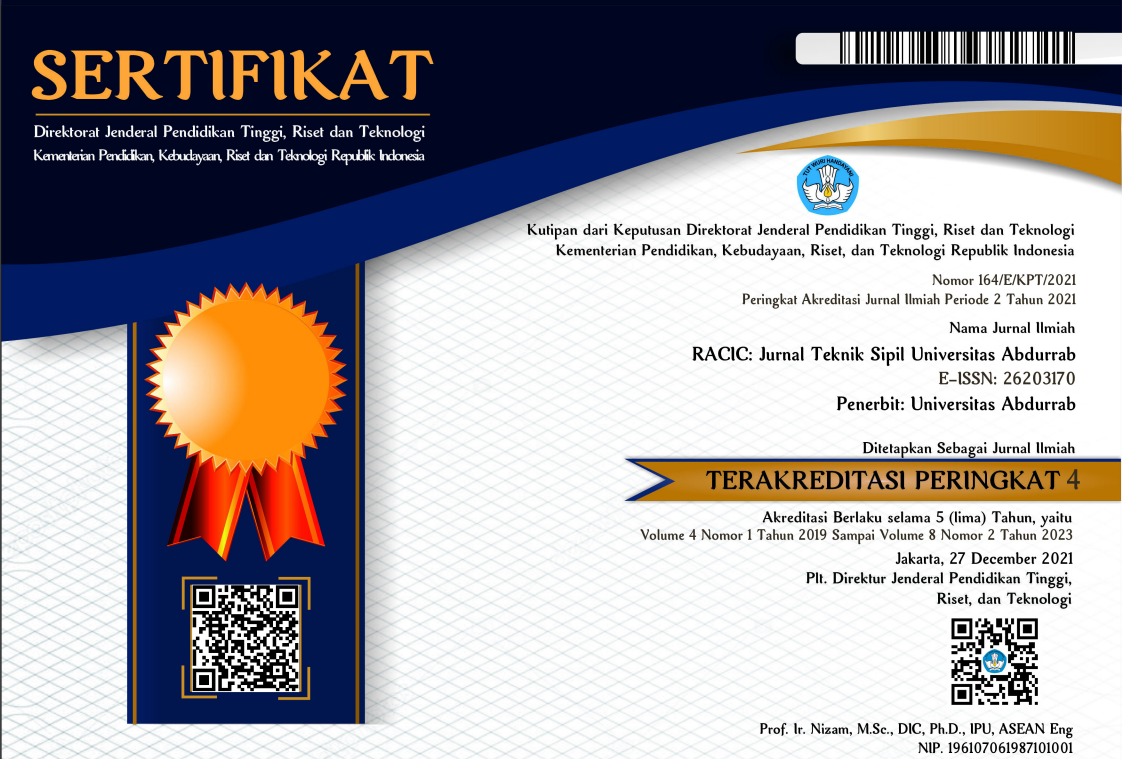PENGARUH SERVANT LEADERSHIP PADA MANAJER PROYEK & KEPUASAN KERJA TERHADAP PROJECT SUCCESS FACTOR
Abstract
Proyek didefinisikan sebagai runtutan tugas yang harus diselesaikan untuk mencapai suatu hasil tertentu. Menurut Project Management Institute (PMI), istilah Proyek mengacu pada "setiap usaha dengan awal dan akhir yang pasti", meliputi berbagai macam industri, termasuk proyek konstruksi. Manajer proyek pada suatu proyek memiliki pengaruh terhadap kinerja pada pelaksanaan suatu proyek. Dengan demikian jenis kepimimpinan pada seorang manajer proyek juga akan berdampak terhadap kesuksesan proyek konstruksi. Lalu kepuasan kerja pada tim proyek merupakan perasaan/pendapat tim proyek akan pekerjaan mereka. Pada penelitian ini dilakukan analisa untuk mengukur pengaruh gaya kepemimpinan servant pada manajer proyek serta kepuasan kerja tim proyek, terhadap keberhasilan proyek dalam hal kinerja jadwal, kinerja biaya, kinerja kualitas, dan kepuasan pemangku kepentingan, terutama pada proyek-proyek konstuksi di Indonesia. Penlitian dilakukan dengan melakukan survey kuantitatif terhadap profesional proyek umum maupun proyek konstruksi di Indonesia dan kemudian hasil survey akan diolah dengan metode Structural Equation Modelling.
References
R. Turner, J. R. Turner, and R. Müller, “The Project Manager’s Leadership Style as a Success Factor on Projects: A Literature Review.” [Online]. Available: https://www.researchgate.net/publication/258568476
V. H. Vroom and A. G. Jaago, “The role of the situation in leadership,” American Psychologist, vol. 62, no. 1, pp. 17–24, Jan. 2007, doi: 10.1037/0003-066X.62.1.17.
S. P. , ; Judge. , T. A. Robbins, Organizational behavior. New Jersey: Pearson Prentice Hall, 2007.
C. J. Davis, Servant Leadership and Followership. Kansas: Palgrave Macmillan, 2017.
Project Management Institute and Project Management Institute, A guide to the project management body of knowledge (PMBOK guide).
G. J. Ritz, Total construction project management. McGraw-Hill, 1994.
R. K. Greenleaf, L. C. Spears, S. R. Covey, and P. M. Senge, “Servant leadership : a journey into the nature of legitimate power and greatness,” p. 370.
-dirk van Dierendonck and lMKE Heeren, “TOWARD A RESEARCH MODEL OF SERVANT-LEADERSHIP”.
J. A. Conger, R. N. Kanungo, and S. T. Menon, “Charismatic leadership and follower e€ects.”
J. A. Conger and R. N. Kanungo, “Charismatic Leadership in Organizations: Perceived Behavioral Attributes and Their Measurement,” 1994. [Online]. Available: http://www.jstor.orgURL:http://www.jstor.org/stable/2488215http://www.jstor.org/stable/2488215?seq=1&cid=pdf-reference#references_tab_contents
L. J. Konczak, D. J. Stelly, and M. L. Trusty, “Defining and measuring empowering leader behaviors: Development of an upward feedback instrument,” Educ Psychol Meas, vol. 60, no. 2, pp. 301–313, 2000, doi: 10.1177/00131640021970420.
S. Harter, “Authenticity,” Handbook of positive psychology, pp. 382–394.
P. E. Spector, “Job Satisfaction : Application , Assessment , Causes , and Consequences The Nature of Job Satisfaction,” The Nature of Job Satisfaction, pp. 1–6, 1997.
R. Kreitner, “Organizational Behavior by Kreitner and Kinicki 9th Edition Ch3 and 4.pdf,” 2010, Accessed: Dec. 11, 2022. [Online]. Available: https://books.google.com/books/about/Organizational_Behavior.html?id=J-oePwAACAAJ
S. Azash, R. Safare, and M. S. Kumar, “THE MOTIVATIONAL FACTORS AND JOB SATISFACTION: A STUDY ON SELECTED PUBLIC AND PRIVATE SECTOR BANK EMPLOYEES IN KADAPA DISTRICT, ANDHRA PRADESH,” 2011.
Fred. Luthans, “Organizational behavior : an evidence-based approach,” p. 574, 2011.
Copyright (c) 2023 RACIC : Rab Construction Research

This work is licensed under a Creative Commons Attribution-NonCommercial-ShareAlike 4.0 International License.
1. Copyright of all journal manuscripts is held by the RACIC : Rab Construction Research
2. Formal legal provisions to access digital articles of electronic journal are subject to the provision of the Creative Commons Attribution-ShareAlike license (CC BY-NC-SA), which means that RACIC : Rab Construction Research is rightful to keep, transfer media/format, manage in the form of databases, maintain, and publish articles.
3. Published manuscripts both printed and electronic are open access for educational, research, and library purposes. Additionally, the editorial board is not responsible for any violations of copyright law.
licensed under a Creative Commons Attribution-ShareAlike 4.0 International License.
 PDF (Bahasa Indonesia)
PDF (Bahasa Indonesia)
 Abstract views: 178
Abstract views: 178
 downloads: 203
downloads: 203

 :
:







